Autumn’s Leaves
/2 Comments/in Design, Planning/by Lee ReichWherefrom the Colors?
Autumn is a season when New York’s Hudson Valley, and much of the Northeast, unfolds in all its glory. Not this autumn, though. What’s going on in the leaves this year? Is there anything I can do about it?.
Chlorophyll is what makes leaves green, but hidden behind that green, all season long, are some of autumn’s colors. Chlorophyll must be continually synthesized for a leaf to stay green. The shorter days and lowering sun of waning summer are what trigger leaves to stop producing chlorophyll and let some of the other colors come to the fore.
Yellows and oranges, no longer masked by chlorophyll green, come from carotenoids, which help chlorophyll do its job of harvesting sunlight to convert into plant energy. Thank carotenoids for the warm, yellow glow they give to gingko, aspen, hickory, and birch leaves.
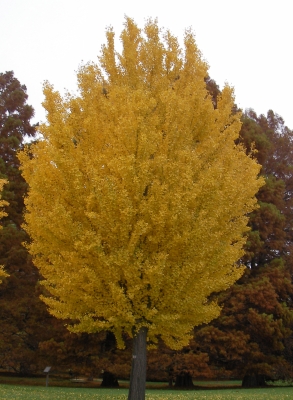
Gingko
Tannins are another pigment, actually metabolic wastes, that all summer are hidden by chlorophyll. Their contribution to the fall palette are the season’s subdued browns, notable in some oaks and enriching the yellow of beeches.
Because leaves harbor carotenoids and tannins all summer long, nothing particular about autumn weather should either intensify or subdue their autumn showing. I’m blaming this autumn’s poor show on the season’s extended warm weather. It was slow to arrest chlorophyll production and induce leaf drop. A couple of hard freezes brought the whole works to a screeching halt, so instead of showy yellow leaves, my witchhazel’s stems are now “adorned” with wrinkled, green leaves frozen in place. Other trees and shrubs suffered a similar fate, and their frozen, green leaves are dropping without any fanfare.
Autumn color also spills out reds and purples, most evident in red maples and some sugar maples, scarlet oak, sourwood, blueberry, and winged euonymus. Those reds and purples come from anthocyanins, yet another pigment. Except for trees like Purple Fountain beech and Royal Purple smokebush, whose leaves unfold dusky red right from the get go in spring and remain so all season long, in most leaves anthocyanins do not begin to develop until autumn.

Sugar maple
Anthocyanin formation requires sugars, which accumulate best with a combination of warm, sunny days to maximize photosynthesis, and cool, but not frigid, nights to minimize nighttime burning up of accumulated sugars. A cloudy, rainy autumn means less red because less anthocyanin is formed, and any that does form is diluted. Warm nights, such as characterized much of autumn, reduce anthocyanins by burning up much of each day’s sugar production. The result: Less reds and purples, as evidenced by the blah color of this year’s blueberries in my garden and maples in the forests.
Can We Make the Color Better?
Is there anything we can do about the autumn show?
Here in the garden, my role in the autumn show is to plant trees genetically programmed for good autumn color. Colorful trees and shrubs include goldenrain tree, hickory, ironwood, and black tupelo. Certain varieties within each species might pack a bigger wow than the others. Hence the spicebush variety Rubra, brick red in fall, or Wright Brothers sugar maple, whose leaves become a mottling of gold, pink, orange, and scarlet. Other especially colorful varieties include Autumn Flame and October Glory red maple, Commemoration and Legacy sugar maple, Autumn Gold and President gingko, and September Beauty Chinese sumac.
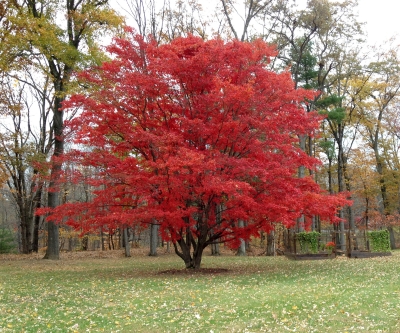
Japanese maple
Despite this autumn’s weather, fothergilla and Japanese stewartia both managed to look as flamboyant this year as in others. If you believe that, going forward, autumn weather is going to bring on less spectacular color, choose varieties that originated from more southerly latitudes.
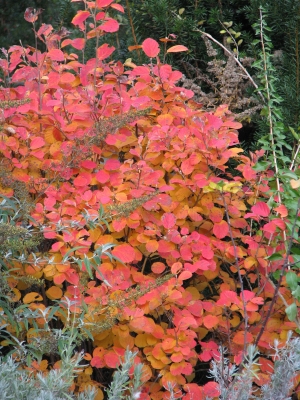
Fothergilla
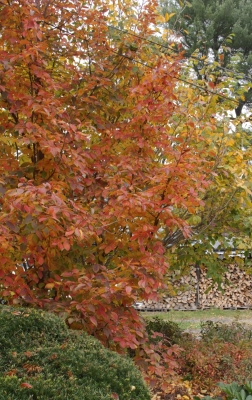
Stewartia
And if warmer autumns are going to be one effect of global warming, we can help the autumn show beyond our gardens, in the forests, by traveling less or more efficiently, using less plastic and other petrochemicals, eating more locally grown food and less farmed meat, investing in energy-efficient appliances and renewable energy, etc. (For more, see https://www.conserve-energy-future.com/stopglobalwarming.php.)
Back in the garden, my other role in ratcheting up the reds and purples is to make sure that leaves bask in light. I plant a tree where light is adequate (for that species) and, as necessary, prune so that branches don’t shade each other. Street lights don’t count as light, and actually have a negative effect, disrupting the signal that days are getting shorter and it’s time to slow chlorophyll production.
Lee’s New Book!!
Knowing something about how plants work can make gardening more interesting as well as make the landscape prettier and vegetable gardens more productive. And that’s the thrust of my upcoming book, The Ever Curious Gardener: Using a Little Natural Science for a Much Better Garden, to be published in early spring of 2018 but available for pre-order through Amazon or, signed, from me.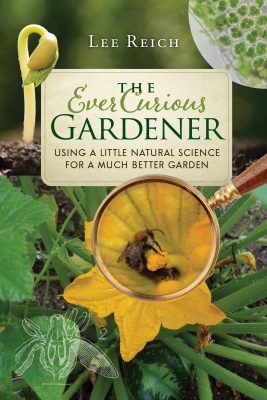
Some Fruits and a Ornamental Veggie
/14 Comments/in Flowers, Fruit, Gardening, Planning, Soil, Vegetables/by Lee ReichHappy Blueberries, Happy Me
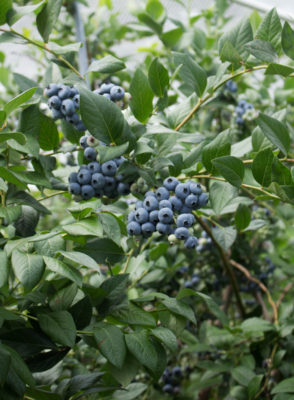
With all those years of mulching, levels of decomposed and decomposing soil organic matter have greatly increased the soil’s buffering capacity for acidity. That means that I no longer have to pay such close attention to acidity, so I rarely add sulfur anymore.
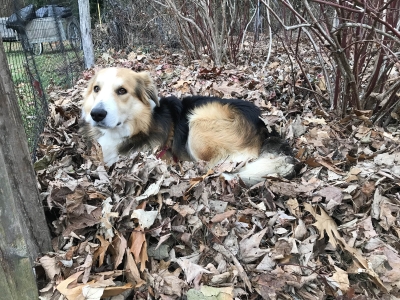
Sammy also likes the mulch
Besides all these other benefit, the mulch has created a soft root run that retains moisture, just what blueberries’ thin roots really like. Fruit is borne on shoots that grew the previous season, so each year’s vigorous new growth translates into a good crop in the offing for the next year.
New York Bananas
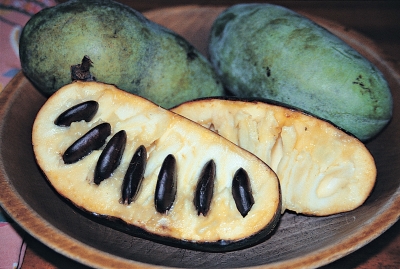
Two trees would be adequate for most households; I have about 20, just so I can learn more about them and their individual differences. That makes for a lot of pawpaws! (I test market most of them.)
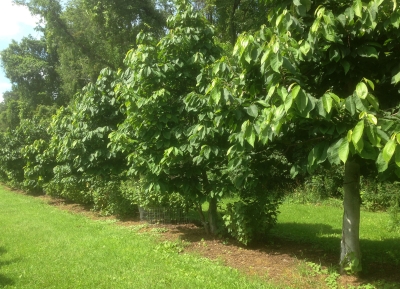
Pawpaw fruits are very variable in both size and flavor even among the branches of a single tree. One year, I tried thinning the fruits to see if that would increase size of remaining fruits, as it does with apples and peaches. Pawpaw has a multiple ovary so each blossom can give rise to as many as 9 fruits. The small fruits are hard to see because they match so closely the green color of the leaves, so I didn’t thin as many as I had hoped. That said, at season’s end, fruits on thinned clusters seemed no larger than fruits on unthinned clusters.
Beginning around the middle of September, I began harvesting the first fruits. I picked some up from the ground and picked some softening ones from the trees, all of which continued through October. By putting them immediately in a cooler at 40°F, I still had good fruit into the middle of November.
Scarlet Runners
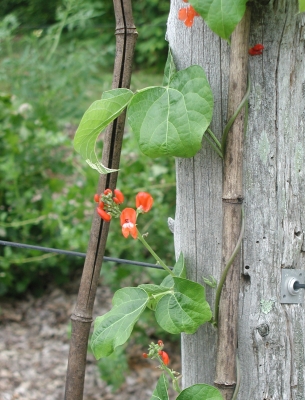
Despite the “bean” in the name, I’ve grown this vining bean, as do most people, primarily as an ornamental, for its scarlet blossoms. I occasionally eat the fat, hairy, yet delectable green beans.
Every year I collect some of the matured black and pale purple, calico seeds for replanting the following year. One year, I decided to cook up some of these seeds and taste them. Scarlet runner bean seeds are quite tasty (and, I learned prior to eating, nonpoisonous).
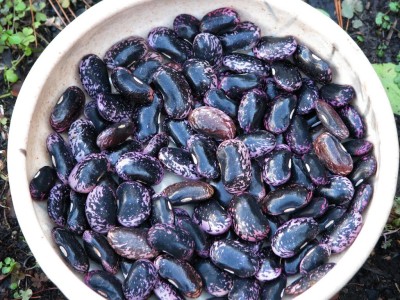
Giving Thanks
/0 Comments/in Gardening, Soil, Uncategorized/by Lee ReichShare the Bounty
Thanksgiving is a holiday that really touches the gardener, this gardener, me, at least. If nothing more, it’s a harvest festival, a celebration of the bounty of the season’s efforts. And the season has been bountiful, as is every season if a variety of crops are grown.
Like most home gardeners, I grow a slew of different vegetables and fruits in my gardens. This year’s poor crops of okra, lima beans, and tomatoes was counterbalanced by especially bounteous crops of peppers, cabbages (Asian and European), and various kinds of corn (sweet corn, popcorn, polenta corn) and beans (green, cannelloni).
More than just give thanks, why not give back? One way would be to share the bounty with others who either don’t garden or can’t afford to purchase enough produce. Ample Harvest (www.ampleharvest.org), Angel Food Ministries (www.AngelFoodMinistries.org), and Feeding America (www.feedingamerica.org) are three organizations that can direct your vegetables and fruits to local pantries. Some gardeners take inspiration from the suggestion of Garden Writers Association to “Plant a Row for the Hungry.”
Thank You, Soil
This Thanksgiving, actually all through autumn (and every autumn), I’m thankful to the soil. Much of life is supported by the thin skin of earth that envelops the earth’s surface. (The skin of an apple is, relatively speaking, proportionally the same to the size of the fruit as the skin of soil is to the size of our planet.)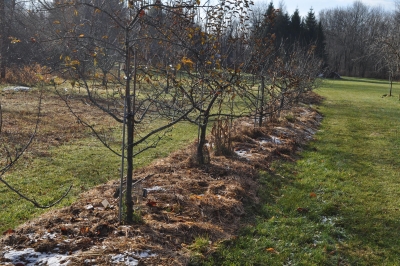
That earthy skin also plays an important role in recycling water and organic materials. Soil stores and purifies water, and is host to 10,000-50,000 species of microorganisms in every teaspoon that break down and recycle waste leaves, tree trunks, dead animals and other organic materials.
I offer thanks to the soil by feeding soil organisms organic materials. I haul in materials that people elsewhere have too much of: bagged leaves; manure mixed with wood shavings and hay from a local horse farm; wood shavings from a sawmill. On site, I feed soil creatures kitchen trimmings, hay mowed from my meadow, old cotton, wool or leather clothing, shredded paper, and anything else derived from what is or was living. Some of the stuff gets spread on the ground as mulch. Some gets composted before being spread on the ground.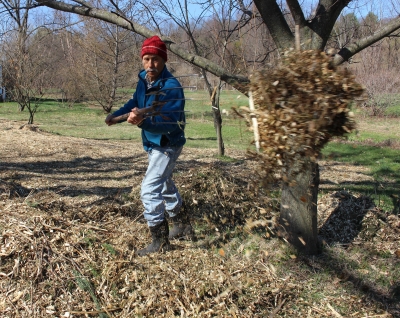
When all is said and done, my ground each years is better, in terms of fertility, soil life, water holding and drainage, than it was the previous year. On the practical side, there’s no need for me to purchase fertilizer.
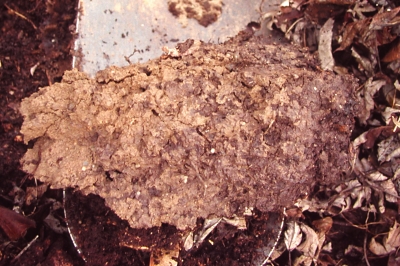
Good, crumbly soil structure
—————————————
That’s not all with this thankfulness. How about the environment generally, not just the soil? Nothing to do this time of year except to carry on as usual. That includes eliminating or minimizing the use of various -icides. Fungicides to kill fungi, insecticide to kill insects, herbicides to kill weeds, acaricides to kill mites, bactericides to kill bacteria . . . did I leave any out?
True, gardening isn’t Nature, and even good gardens get occasional pest problems. But, as I wrote above, most gardens easily yield an abundance of vegetables, fruits, or flowers, so some could be sacrificed to (shared with?) pests.
And there’s something to be said for ignoring a certain amount of damage, especially if it is only cosmetic. After all, plants tolerate the damage. The remaining parts of a leaf that has been chewed away by and insect, for example, then step up to bat with beefed up photosynthesis.
On the rare occasions when it’s necessary to reach for some -icide to do in a pest has gotten sufficiently out of control to seriously threatens a plant, I opt for environmentally-friendly alternatives. I’ll use the pest-specific bacterial fungicide Bacillus thurengiensis (sold under such trade names as Thuricide and Dipel) to kill the various cabbage worms (they’re actually not “worms” but “caterpillars”). And insecticidal soap or horticultural oil to kill scale insects and mealybugs, and certain fungi, and pans of beer to attract and kill slugs.
Mostly, though, I let Nature take care of itself, within reason. I decide what plants to put in my gardens and what plants to weed out (weeds). Severe pest outbreaks require a decision on whether action is necessary or whether the particular crop can be sacrificed. (That’s the advantage of home gardens: financial decisions don’t rule and diversity means there’s always plenty of other vegetables or fruits to harvest.) I regularly “feed” the little guys in the soil who, in turn, feed the plants to replenish nutrients they take from the soil, and then are moved further offsite into my kitchen.
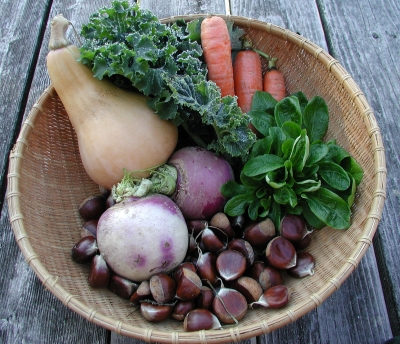
Thanksgiving harvest

